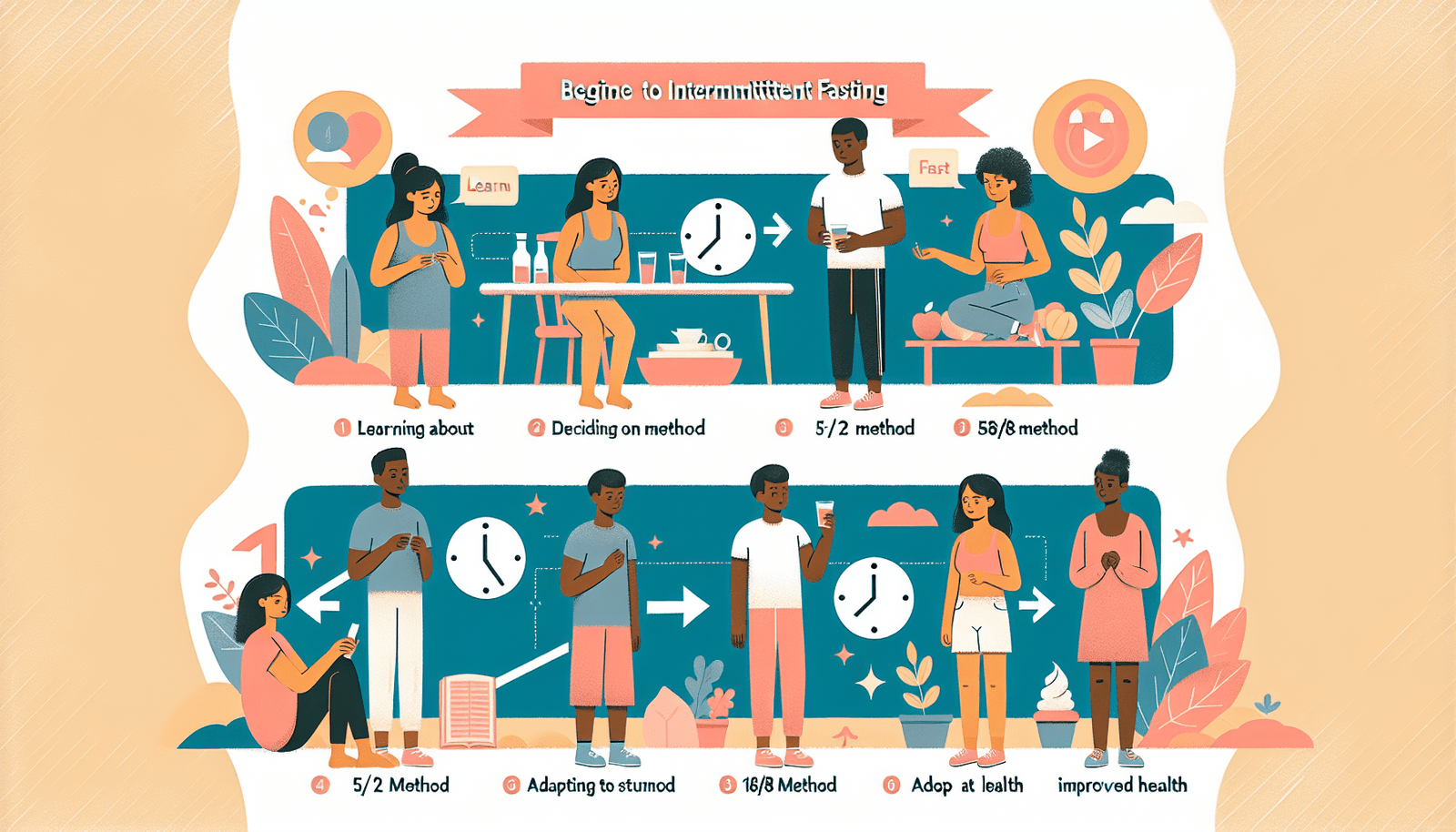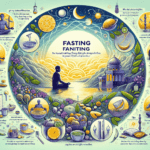So you’ve heard about the potential benefits of intermittent fasting and you’re ready to give it a try. But where do you start? In this article, we’ll guide you through the basics of how to effectively practice intermittent fasting as a beginner. We’ll break down the different fasting methods, provide tips for success, and address some common misconceptions along the way. By the end, you’ll have a clear understanding of how to incorporate intermittent fasting into your lifestyle and reap its potential health benefits. Buckle up, because we’re about to embark on a journey towards a healthier you through intermittent fasting.

Understanding Intermittent Fasting
What is intermittent fasting?
Intermittent fasting is a dietary approach that involves alternating periods of fasting and eating. Unlike traditional diets that focus on what you eat, intermittent fasting is more about when you eat. It is less of a diet and more of an eating pattern.
Different approaches to intermittent fasting
There are several different approaches to intermittent fasting, allowing you to choose the one that best suits your lifestyle and preferences. Some popular methods include the 16/8 method, the 5:2 diet, alternate-day fasting, and the eat-stop-eat method.
Benefits of intermittent fasting
Intermittent fasting has gained popularity not only for its potential weight loss benefits but also for its positive effects on overall health. Research suggests that intermittent fasting may help improve insulin sensitivity, boost metabolism, promote cellular repair, reduce inflammation, and even support brain health.
Choosing the Right Intermittent Fasting Approach
Exploring the 16/8 method
The 16/8 method is one of the most popular forms of intermittent fasting. It involves fasting for 16 hours and restricting eating to an 8-hour window each day. This approach is relatively easy to incorporate into your daily routine as it simply involves skipping breakfast and having all your meals between noon and 8 pm.
Understanding the 5:2 diet
The 5:2 diet involves eating normally for five days of the week and restricting calorie intake to 500-600 calories for the remaining two days. The non-fasting days are not entirely unlimited, but the focus is on reducing calorie intake rather than full fasting. It is important to pay attention to the quality of food consumed on both fasting and non-fasting days.
Trying alternate-day fasting
Alternate-day fasting involves alternating between days of regular eating and days of fasting. On fasting days, caloric intake is significantly reduced or eliminated altogether. This approach may be more challenging for beginners due to the extended periods of fasting, but it can be effective for weight loss and other health benefits.
Considering the eat-stop-eat method
The eat-stop-eat method involves fasting for 24 hours once or twice a week. This means that you would have dinner one day and not eat again until dinner the following day. While this approach may seem daunting, it provides a clear distinction between fasting and non-fasting days, making it easier to adhere to the schedule.
Preparing Yourself for Intermittent Fasting
Consulting your healthcare provider
Before diving into any new dietary regimen, it is always wise to consult with a healthcare provider, especially if you have any underlying health conditions or concerns. They can provide personalized advice and guidance based on your individual needs.
Assessing your current dietary habits
Take some time to evaluate your current eating habits and identify areas for improvement. Are you consuming a balanced and nutritious diet? Are there any unhealthy eating patterns or trigger foods that you need to address? This self-assessment can help you identify areas where intermittent fasting may be beneficial.
Setting realistic goals
When starting intermittent fasting, it is important to set realistic goals. Focus on sustainable and long-term changes rather than rapid weight loss. Setting achievable goals will help keep you motivated and prevent feelings of disappointment or frustration.
Creating a fasting schedule
Create a fasting schedule that aligns with the intermittent fasting approach you have chosen. Plan your meals and fasting windows accordingly, and consider using an app or a timer to help you keep track of your fasting periods. Consistency is key when it comes to reaping the benefits of intermittent fasting.

Managing Hunger and Cravings
Drinking plenty of water
Staying well-hydrated is crucial during intermittent fasting. Drinking plenty of water can help reduce hunger pangs and cravings. It is recommended to aim for at least eight glasses of water per day and to drink a glass before meals to help with portion control.
Consuming fiber-rich foods
Fiber-rich foods such as fruits, vegetables, whole grains, and legumes can help keep you feeling full and satisfied during fasting periods. Including these foods in your meals can also support digestion and contribute to overall gut health.
Incorporating healthy fats and protein
Healthy fats and protein are also important for managing hunger and cravings during intermittent fasting. Foods like avocados, nuts, seeds, lean meats, and fish can provide essential nutrients and help keep you satiated throughout the day.
Using appetite suppressants (if necessary)
In some cases, using natural appetite suppressants may be helpful in managing hunger and cravings during intermittent fasting. Options such as green tea, coffee, or spices like cinnamon can help curb appetite. However, it is important to be mindful of any potential side effects or interactions with medications.
What to Eat and Drink During Intermittent Fasting
Foods to include in your meals
When breaking your fast, focus on nutritious, whole foods. Include a variety of fruits, vegetables, lean proteins, whole grains, and healthy fats in your meals. Aim for a well-balanced plate that provides essential nutrients while still fitting within your caloric needs.
Healthy snacks that won’t break your fast
If you find yourself needing a snack during fasting periods, choose options that are low in calories and won’t break your fast. Options include raw vegetables, unsweetened herbal tea, or a handful of nuts. These snacks can help keep hunger at bay without interrupting the fasting process.
Recommended beverages during fasting
During fasting periods, it is essential to avoid any beverages that contain calories, as this can break your fast. Stick to water, unsweetened herbal tea, black coffee, or sparkling water to stay hydrated and satiated.
Be cautious of hidden calories
When incorporating intermittent fasting, it’s important to be cautious of hidden calories, especially during your eating windows. Sugar-sweetened beverages, processed snacks, and excessive portion sizes can negate the benefits of fasting. Be mindful of your food choices and focus on nutrient-dense, whole foods to maximize the benefits of intermittent fasting.
Staying Consistent and Motivated
Tracking your progress
Tracking your progress can help keep you motivated and accountable. Keep a journal or use a mobile app to record your fasting and eating windows, meals, and any changes you observe in your body or overall well-being. This documentation can serve as a reminder of your progress and help identify any areas that may need adjustment.
Finding support and accountability
Engaging with others who are also practicing intermittent fasting can provide support and accountability. Joining online communities or finding a fasting buddy can give you a sense of community and shared experiences. Discussing challenges, exchanging tips, and celebrating milestones together can make the journey more enjoyable and sustainable.
Maintaining a positive mindset
Intermittent fasting can be challenging at times, especially in the beginning. Maintaining a positive mindset and focusing on the benefits can help you stay motivated during the tougher moments. Remember why you decided to try intermittent fasting and focus on the positive changes it can bring to your health and well-being.
Rewarding yourself for milestones
Set small milestones for yourself and reward yourself when you reach them. Celebrate your progress with non-food rewards such as treating yourself to a massage, buying a new book, or enjoying a day trip. These rewards can serve as both motivation and a way to practice self-care throughout your intermittent fasting journey.
Exercising and Intermittent Fasting
Understanding the impact of exercise
Exercise has numerous health benefits and can be effectively combined with intermittent fasting. It can support weight loss, improve cardiovascular health, boost mood, and increase muscle strength. However, it is important to listen to your body and adjust the intensity and duration of your workouts as needed.
Choosing the right workout regimen
When practicing intermittent fasting, it is important to choose a workout regimen that aligns with your fasting schedule and personal preferences. Some individuals find fasted workouts energizing and prefer to exercise during their fasting window, while others may feel more comfortable exercising after breaking their fast. Experiment and find a routine that works best for you.
Timing your workouts with fasting
If you choose to exercise during your fasting window, it is important to fuel your body appropriately before and after your workout. Consuming a small snack or a balanced meal rich in protein and carbohydrates before your workout can provide energy. After your workout, be sure to refuel with a nutrient-dense meal to aid in recovery and muscle repair.
Fueling your body post-workout
When breaking your fast after a workout, it is important to focus on replenishing your body with the necessary nutrients. Including lean protein for muscle repair, complex carbohydrates for energy, and healthy fats for satiety can help optimize recovery and support your fitness goals.
Common Challenges and How to Overcome Them
Dealing with hunger pangs
Hunger pangs are a common challenge when starting intermittent fasting. To overcome them, stay hydrated, consume fiber-rich foods, and incorporate healthy fats and protein into your meals. Additionally, distract yourself with activities or hobbies to take your mind off the hunger.
Managing social situations
Social situations that revolve around food can be challenging when practicing intermittent fasting. To navigate these situations, plan ahead by communicating your fasting schedule with friends and family. Opt for social activities that do not revolve solely around eating, and if necessary, suggest alternative activities or bring your own nutritious meal or snack.
Coping with food cravings
Food cravings can be difficult to manage, especially during fasting periods. Distract yourself with other activities, chew sugar-free gum, or brush your teeth to help curb cravings. Additionally, remind yourself of your goals and the benefits of intermittent fasting to stay motivated and avoid giving in to the cravings.
Handling plateaus in weight loss
Experiencing weight loss plateaus is common during intermittent fasting. To overcome plateaus, reassess your caloric intake and make sure you are not overeating during your eating windows. Incorporate resistance training into your exercise routine to build muscle and boost your metabolism. Additionally, consider adjusting your fasting schedule or trying a different intermittent fasting approach to stimulate further progress.
Monitoring and Adapting Your Approach
Noting changes in energy levels and mood
As you practice intermittent fasting, pay attention to any changes in your energy levels and mood. Some individuals may experience increased energy and improved mood, while others may notice fluctuations. Adjust your fasting schedule, meal composition, or exercise regimen accordingly to find what works best for your body.
Adjusting your fasting window if needed
If you find that your chosen fasting window is too difficult to sustain or not providing the desired results, don’t hesitate to adjust it. Experiment with different fasting windows and meal timings until you find a schedule that is both manageable and effective for you.
Considering modifications for health conditions
Certain health conditions may require modifications to intermittent fasting or close monitoring by a healthcare professional. If you have diabetes, low blood sugar, or other chronic health conditions, work closely with your healthcare provider to ensure that intermittent fasting is safe and appropriate for your specific needs.
Reevaluating your goals and progress
Periodically, take the time to reevaluate your goals, progress, and overall satisfaction with intermittent fasting. Are you still seeing the results you desire? Are you enjoying the process? Adjust your goals, fasting schedule, or approach as needed to ensure that it remains a sustainable and fulfilling lifestyle choice for you.
Seeking Professional Guidance
Working with a nutritionist or dietitian
If you need personalized guidance and support while practicing intermittent fasting, consider working with a nutritionist or dietitian. These professionals can provide expert advice tailored to your specific needs, help you make informed food choices, and address any concerns or questions you may have.
Getting personalized advice and recommendations
An experienced nutritionist or dietitian can offer personalized advice and recommendations based on your health goals, dietary preferences, and lifestyle. They can help you create a customized intermittent fasting plan that suits your individual needs and maximizes the potential benefits.
Addressing any health concerns or questions
A nutritionist or dietitian can address any health concerns or questions you may have about intermittent fasting. They can guide you in managing any medical conditions, medications, or dietary restrictions, ensuring that you practice intermittent fasting safely and effectively.
Learning from experienced fasting practitioners
Nutritionists and dietitians who specialize in intermittent fasting can provide valuable insights and tips based on their experience working with individuals who have successfully incorporated intermittent fasting into their lifestyles. Their expertise can help you navigate challenges, optimize your fasting approach, and achieve your health goals.
By understanding intermittent fasting, choosing the right approach, preparing yourself mentally, managing hunger and cravings, knowing what to eat and drink during fasting, finding support, exercising effectively, overcoming common challenges, monitoring your progress, and seeking professional guidance, you can effectively practice intermittent fasting as a beginner. With consistency and the right mindset, intermittent fasting can be a sustainable and rewarding lifestyle choice that supports your overall health and well-being.







